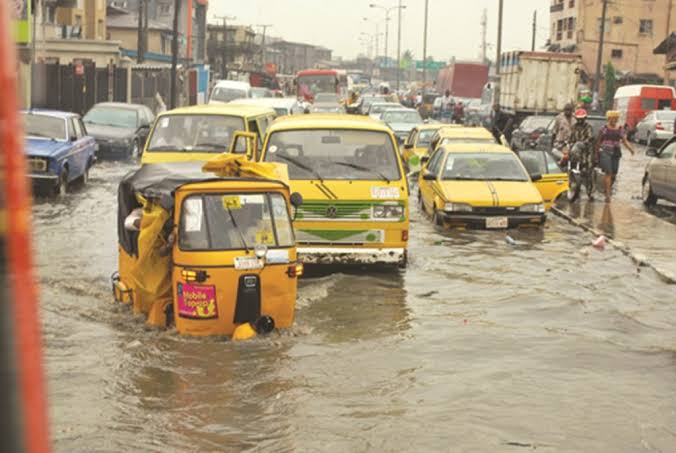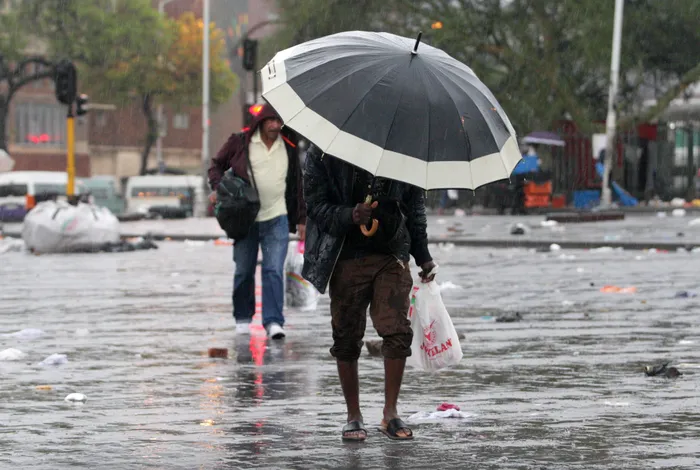Lagos residents battle flood: Here are safety precautions for flooding

Image Source: News Central TV
A heavy downpour on Wednesday has led to flooding and traffic jams across Lagos State, disrupting activities in Nigeria’s commercial hub and affecting schools and homes.
Viral videos on social media showed flooding in areas like Iyana-Oworo, Oshodi, Lekki, Ikeja, Egbeda, and Gbagada. The flooded roads were almost impossible to drive on, causing traffic jams and discomfort for commuters.
Lagos, Nigeria’s bustling commercial hub, often faces severe flooding, especially during the rainy season. This causes significant damage to homes, businesses, and infrastructure. For residents, knowing how to stay safe during floods is crucial. Here are some safety precautions to help you protect yourself and your loved ones.
READ ALSO
What is drug abuse? UNODC, NDLEA intensify action as Nigeria battles substance abuse
‘It wasn’t easy’ — CrispNG’s Ndidiamaka Ede bows out as UCJ-UNN president
Wike vs Ireti Kingibe: Why FCT heavyweights are at loggerheads
Safety Precautions Before a Flood
1. Prepare an Emergency Kit: Have a kit ready with essential items such as water, non-perishable food, medications, first aid supplies, flashlights, batteries, and important documents.
2. Know Your Risk: Stay informed about flood-prone areas in Lagos and assess your home’s flood risk. Familiarize yourself with local emergency plans and evacuation routes.
3. Secure Your Home: Install check valves to prevent floodwater from backing up into your drains. Seal walls in basements with waterproof compounds to avoid seepage.
4. Stay Informed: Monitor weather forecasts and listen to local news for updates on flood warnings and advisories. Sign up for emergency alerts if available.
Safety Precautions During a Flood
1. Evacuate if Advised: If local authorities recommend evacuation, do so immediately. Follow recommended routes and avoid shortcuts, as they may be blocked or dangerous.
2. Avoid Floodwaters: Do not walk, swim, or drive through floodwaters. Just six inches of moving water can knock you down, and one foot of moving water can sweep your vehicle away.
3. Move to Higher Ground: If you are trapped by rising water, move to the highest point possible, such as the roof. Take your emergency kit with you if you can.
4. Stay Away from Electrical Equipment: Do not touch electrical equipment if you are wet or standing in water. Turn off the power at the main switches if it is safe to do so.
5. Avoid Contaminated Water: Floodwater may be contaminated with sewage, chemicals, and other hazardous substances. Avoid contact and ensure you boil or treat water before drinking.
Safety Precautions After a Flood
1. Return Home Safely: Wait for local authorities to declare that it is safe to return. Be cautious of potential hazards such as structural damage, downed power lines, and contaminated water.
2. Clean Up Safely: Wear protective clothing, including gloves and boots, during cleanup. Discard any food and water that may have been contaminated.
3. Prevent Mold: Dry out your home as quickly as possible. Use fans, dehumidifiers, and open windows to circulate air. Clean and disinfect all surfaces to prevent mold growth.
4. Seek Help: If your home has suffered significant damage, seek professional assistance. Contact local authorities and relief organizations for support and resources.
5. Keeping Drains Clear: Ensure that drains and gutters are free of debris. Join or organize efforts to clean up local waterways and drainage systems.
6. Advocating for Better Infrastructure: Support initiatives for improved drainage and flood control systems.




